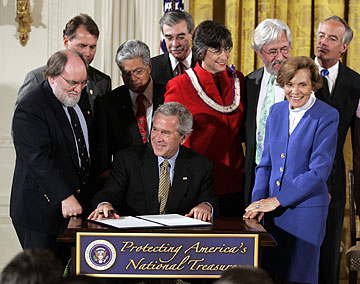Monument status a splendid milestone for precious islands
THE ISSUE
Establishing the Northwestern Hawaiian Islands as a national monument will provide strong protections for the ecosystem.
|
PRESIDENT Bush's
astounding designation of the Northwestern Hawaiian Islands as a national monument surprised many an advocate for the environment and for preservation.
They can hardly be faulted since Bush has rarely championed protection of ecosystems and natural areas from extractive industries and commercial interests. That the vast stretch of islands, reefs and ocean contains little of easily gleaned value might have made his decision easier.
No matter. The safeguards the designation now promise for the nearly 140,000-square-mile monument is cause for great celebration. The NWHI is home to more than 7,000 marine species, a quarter of which are found nowhere else in the world, and 14 million seabirds. It encompasses 4,500 square miles of coral reef habitat and the only remaining large-predator ocean ecosystem.
The monument status circumvents a complicated process to establish the islands as a national marine sanctuary that began after President Clinton created a coral reef reserve in the area more than five years ago.

ASSOCIATED PRESS
President Bush signed a proclamation yesterday on the establishment of the Northwestern Hawaiian Islands as a marine sanctuary in the East Room of the White House. Looking on are, from left to right, Rep. Neil Abercrombie, D-Hawaii; Rep. Ed Case, D-Hawaii; Sen. Daniel Akaka, D-Hawaii; Commerce Secretary Carlos Gutierrez; Hawaii Gov. Linda Lingle; documentary filmmaker Jean-Michel Cousteau; marine biologist Sylvia Earle; and Interior Secretary Dirk Kempthorne.
|
|
As a national monument, the archipelago that extends 1,400 miles beyond Hawaii's main islands will enjoy stronger protections than had been considered as a sanctuary.
Commercial fishing, which might have been allowed in a sanctuary, will be phased out in five years, and other extractive uses, such as coral mining, will be prohibited. The area will remain open to Hawaiians for traditional activities and to scientific and educational research. Dumping and unauthorized water craft will be banned.
Though most in Hawaii hailed the designation, the eight remaining commercial outfits licensed to fish in the region's waters might not be pleased. Kitty Simonds, executive director of the Western Pacific Fishery Management Council, which had pushed for fishing rights under a sanctuary, told the New York Times that the group planned to fight the fishing ban. However, it appears that might be a futile pursuit. We hope so.
The designation will allow activity at Midway Atoll, where an emergency landing strip for commercial and military aircraft will be retained. It might also serve as a jumping point for recreational and visitor activity, but those should be restricted to Midway to prevent harm to the other areas.
The monument will be the first operated by the U.S. Commerce Department, though it also oversees other national marine sanctuaries. The unusual assignment has drawn a bit of wariness from environmental groups, but they and other members of the public will have a chance to weigh in on the plan in the coming months.
Meanwhile, Hawaii and the nation should be cheered by this landmark conservation measure.

